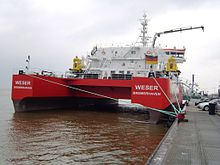Siegholdwerft
The Siegholdwerft was a shipyard in Bremerhaven that existed from 1924 to 1988 .
History of the Sieghold shipyard
In the northern part of Bremerhaven's fishing port II, the smallest sea-going shipyard , Sieghold-Werft Bremerhaven GmbH & Co, had its seat on the east bank . Founded in 1924 by Max Sieghold (1899–1955) as a forge and locksmith's shop, this company initially only repaired household appliances. Four years later Sieghold converted the first fish steamer. He also manufactured mechanical transport systems for fresh herring. With this work, the original craft business turned into an industrial company.
In 1937 the Sieghold shipyard moved to its new location on the east side and put a floating dock into operation, the first in the Lower Weser area . During the Second World War, outpost boats were refitted with a team of 120 men and fish steamer repaired and rebuilt.
On December 15, 1950, the keel was laid for the first new building. The launch of Cornelia Sieghold took place on June 5, 1951, or rather a pile lift on two cranes. It was a coaster with the hull number 101. The next new building with the number 102 was the Bernhard . Then the HJ Kyvik was built for a Norwegian shipping company. Then Sieghold built the new building no. 104, a customs pontoon for the regional tax office in Bremen. Then the construction of a new Cornelia Sieghold with 300 GRT took place under construction no. 105 instead.
The company founder Max Sieghold died in 1955. After his death, his brother, the Geestemünder banker Heinz Sieghold (1898–1973), and then the two sons of the founder, Heinz and Gralf Sieghold, continued the company. Larger site expansions in the 1960s gave the shipyard its later face. In addition to ship repairs - the two floating docks each lifted 3,200 t - the range of services offered by the Sieghold shipyard also included the construction of new fishing vessels, Schottel tugs and coastal tankers, which in 1964 was the first Bremerhaven shipyard to build and repair offshore systems (e.g. Transocean 2 ) recorded.
In 1960 the Sirius tug was launched at Sieghold under construction number 115 for the Hanseatic City of Bremen Office, Bremerhaven . The ship had a length of 21.51 m, a width of 5.8 m and a draft of 2.7 m. In 1974 Sieghold built a fisheries research ship named Solea for the Federal Ministry of Food, Agriculture and Forestry . With a length of 35.37 m, a width of 9 m and 4.4 m draft it had 337.40 GRT.
In 1984 the dock ship Super-Servant 1 of the Sieghold shipyard brought the three-legged Transocean 7 oil rig . A heater and weather protection were installed for the colder region of the North Sea . In August 1984, three shifts at the Sieghold shipyard worked around the clock, around a hundred workers, to overhaul the FGMcClintock oil rig within four months and to convert it for special use in the North Sea. With the repair of trawlers , tugs , cutters and, since 1964, oil rigs as well as the construction of new ships, the family business, which at times had 400 employees, held its own until 1988.
In 1988 Wilhelm Werst wrote in Schiffahrt International that this specialty, namely the worldwide repair of drilling rigs at the Sieghold shipyard, was undoing. The US drilling company Reading & Beates left the Sieghold shipyard sitting on unpaid bills of more than five million marks. So the shipyard management had no choice but to sell the shipyard to the Bremer Vulkan . The takeover of the business was tantamount to closing the shipyard. With the integration into the shipyard network under the dominance of the volcano, the construction of new ships ended.
On September 30, 1988, Bremerhaven's smallest shipyard closed its doors forever. After the sale of the floating docks, the successor company Höhne Anlagenbau only occasionally carried out work on ships. For a short time, Abeking & Rasmussen have been building innovative Swath- style pilot station ships on the site .

